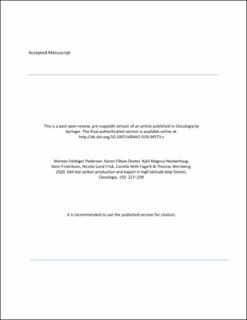| dc.contributor.author | Pedersen, Morten Foldager | |
| dc.contributor.author | Filbee-Dexter, Karen | |
| dc.contributor.author | Norderhaug, Kjell Magnus | |
| dc.contributor.author | Fredriksen, Stein | |
| dc.contributor.author | Frisk, Nicolai Lond | |
| dc.contributor.author | Fagerli, Camilla With | |
| dc.contributor.author | Wernberg, Thomas | |
| dc.date.accessioned | 2020-09-10T12:51:25Z | |
| dc.date.available | 2020-09-10T12:51:25Z | |
| dc.date.created | 2020-06-16T17:07:39Z | |
| dc.date.issued | 2020 | |
| dc.identifier.citation | Oecologia. 2020, 192 (1), 227-239. | en_US |
| dc.identifier.issn | 0029-8549 | |
| dc.identifier.uri | https://hdl.handle.net/11250/2677281 | |
| dc.description | Embargo until 13.12.2020 | en_US |
| dc.description.abstract | The production and fate of seaweed detritus is a major unknown in the global C-budget. Knowing the quantity of detritus produced, the form it takes (size) and its timing of delivery are key to understanding its role as a resource subsidy to secondary production and/or its potential contribution to C-sequestration. We quantified the production and release of detritus from 10 Laminaria hyperborea sites in northern Norway (69.6° N). Kelp biomass averaged 770 ± 100 g C m−2 while net production reached 499 ± 50 g C m−2 year−1, with most taking place in spring when new blades were formed. Production of biomass was balanced by a similar formation of detritus (478 ± 41 g C m−2 year−1), and both were unrelated to wave exposure when compared across sites. Distal blade erosion accounted for 23% of the total detritus production and was highest during autumn and winter, while dislodgment of whole individuals and/or whole blades corresponded to 24% of the detritus production. Detachment of old blades constituted the largest source of kelp detritus, accounting for > 50% of the total detrital production. Almost 80% of the detritus from L. hyperborea was thus in the form of whole plants or blades and > 60% of that was delivered as a large pulse within 1–2 months in spring. The discrete nature of the delivery suggests that the detritus cannot be retained and consumed locally and that some is exported to adjacent deep areas where it may subsidize secondary production or become buried into deep marine sediments as blue carbon. | en_US |
| dc.language.iso | eng | en_US |
| dc.publisher | Springer | en_US |
| dc.title | Detrital carbon production and export in high latitude kelp forests | en_US |
| dc.type | Peer reviewed | en_US |
| dc.type | Journal article | en_US |
| dc.description.version | acceptedVersion | en_US |
| dc.source.pagenumber | 227-239 | en_US |
| dc.source.volume | 192 | en_US |
| dc.source.journal | Oecologia | en_US |
| dc.source.issue | 1 | en_US |
| dc.identifier.doi | 10.1007/s00442-019-04573-z | |
| dc.identifier.cristin | 1815844 | |
| dc.relation.project | Norges forskningsråd: 255085 | en_US |
| cristin.ispublished | true | |
| cristin.fulltext | postprint | |
| cristin.qualitycode | 1 | |
